A reliable sprinkler system is a must for your home’s garden and lawn care. Whether dealing with long-blooming flower beds or large expanses of grassy meadows, finding the correct type of sprinkler system helps ensure your outdoor space looks and feels just right.
But how do you determine which type is best for your purposes? From oscillating to pulsing, zone-targeted to rotary sprayers – there are many different styles on the market today, so let’s dive into the themes and pros & cons of each one to help make deciding on a sprinkler simple.
Benefits of Installing a Sprinkler System
Installing a sprinkler system can provide numerous benefits for any homeowner, ranging from improved water conservation to less manual labor. Let’s take a look at some of the key advantages:
- Automation: Automatic sprinklers take the hassle out of manual watering, eliminating any need to set reminders or worry about scheduling.
- Cost savings: Installing an automatic sprinkler system can save money on your water bills, as it regulates and optimizes water usage.
- Improved coverage: Sprinklers provide an even range of your lawn or garden, ensuring every inch receives the necessary water.
- Reduced evaporation: Sprinklers minimize water loss due to wind and sun exposure, resulting in more efficient watering.
- Environmental protection: Using less water sprinkler systems helps conserve precious resources and protect our environment.
There’s no doubt that sprinklers are an invaluable tool for anyone looking to maintain a beautiful outdoor space while saving time and money. So, if you’re ready to give your lawn the attention it deserves, research the best sprinkler options available.
Popular Types Of Lawn Sprinklers: Working Principle
Let’s take a closer look at seven popular lawn sprinkler types:
1-Oscillating Sprinklers:
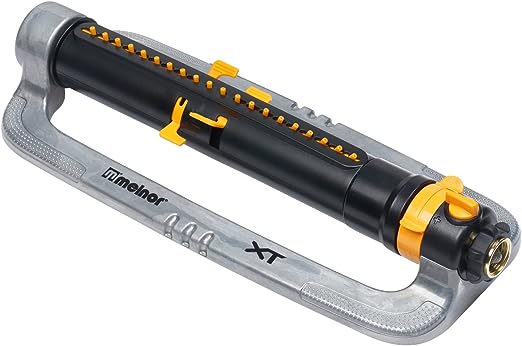
Oscillating sprinklers are a popular irrigation system used for watering lawns and gardens. Instead of relying on stationary spray heads, sprinklers oscillate back and forth, distributing water in a fan-like pattern.
The sprinkler head contains a series of gears that rotate, controlling the flow and direction of the water. The gears move the sprinkler head back and forth, which propels water out of the nozzles. The key to an efficient oscillating sprinkler system is choosing the correct water pressure and adjusting the oscillation range. An oscillating sprinkler can provide even coverage and prevent overwatering with the correct settings.
Pros:
- Oscillating sprinklers: the champions of watering rectangular grass areas, like traditional lawns.
- Some models can drench up to a whopping 4,000 square feet.
- This versatile sprinkler excels at both low and high-water pressure scenarios.
Cons:
- But wait, there’s a catch. Oscillating sprinklers won’t make the cut for watering oddly shaped, rounded, or curved lawns. They miss the mark.
- If you’ve got a budget-friendly model, be prepared for puddles. Some oscillating sprinklers struggle with low water pressure.
- Conversely, if the water pressure is sky-high, brace yourself for a sprinkler that goes the extra mile. They’re effective but lack the finesse of other types.
2- Pulsating Sprinklers:
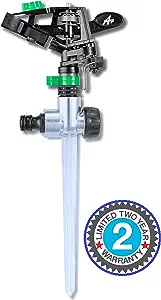
Pulsating sprinklers are a popular option for medium to large lawns. These sprinklers feature an adjustable nozzle that oscillates back and forth, spraying water in an arc-like pattern.
The nozzle determines the size of the spray radius, so it’s essential to select the right size for your needs. When installing pulsating sprinklers, ensure the spray nozzles are installed at a uniform height for an even water pattern.
Pros:
- Pulsating sprinklers are ideal for watering large lawns or gardens, as they can cover up to 5,000 square feet.
- They’re easy to install and have adjustable coverage options, so you can customize your sprinkler system to fit your needs.
- The oscillating nozzle decreases water waste and helps avoid dry spots.
Cons:
- It’s essential to keep an eye on the nozzle size, as a too-small one can lead to oversaturation and runoff.
- Also, if you’re dealing with low water pressure, it may be difficult for pulsating sprinklers to cover larger areas.
3-Stationary Sprinklers:
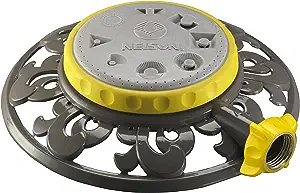
Stationary sprinklers are an ideal option for small and medium-sized lawns. This type of sprinkler has static nozzles that spray water in a circular pattern, creating even coverage across the yard.
The water pressure sets the radius of the spray, so it’s essential to get the correct nozzle size. When setting up your stationary sprinkler system, ensure the nozzles are installed in a uniform pattern. This will provide even coverage and help avoid dry spots or over-watering.
Pros:
- A stationary sprinkler’s most significant benefit is its ability to precisely cover small to medium areas by evenly distributing water within its designated radius.
- It is relatively inexpensive compared to other spray sprinklers and is an excellent option for lawns with limited space.
- Stationary sprinklers are also easy to install and maintain, making them suitable for DIYers.
Cons:
- Unfortunately, stationary sprinklers are no match for more extensive areas due to their fixed coverage area.
- Also, the water pressure needs to be monitored regularly to ensure that the radius is maintained. Keeping a watchful eye can be time-consuming and tedious.
4- Impact Sprinklers:

Impact sprinklers are the perfect choice for large, open areas. This type of sprinkler has a spinning arm that propels water out in a circular pattern. The spinning arm is powered by the force of the water pressure, creating a consistent and uniform spray radius. When installing an impact sprinkler system, it’s essential to ensure that the nozzles are seated at a constant height to prevent dry spots or over-watering.
Pros:
- Impact sprinklers are ideal for large properties, covering up to 8,000 square feet.
- The spinning arm creates an even spray pattern and prevents evaporation and runoff.
- Also, you can adjust the spray radius and arm speed to customize your coverage.
Cons:
- Impact sprinklers require a relatively high water pressure, about 35 psi or more, for optimal performance.
- They also tend to be on the pricier side compared to other types of sprinklers. Lastly, impact sprinklers are best suited for open areas and may struggle in areas with multiple obstacles.
5- Rotor Sprinklers:
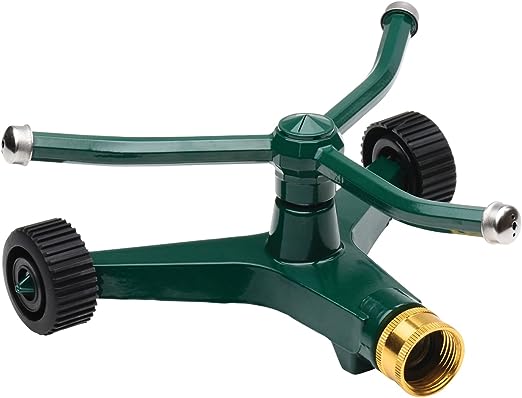
Lastly, rotor sprinklers are the go-to choice for large properties with oddly shaped lawns. This type of sprinkler features a rotating nozzle that produces a steady stream of water in an arc-like pattern.
The nozzle determines the size and shape of the spray radius, so it’s essential to select the right size for your watering needs. When setting up this type of sprinkler, it’s necessary to ensure that the nozzles are installed in a uniform pattern for even water coverage.
Pros:
- Rotor sprinklers are great for watering large and oddly shaped areas.
- They also have a good coverage range of up to 8,000 square feet, allowing for adjustable spray radius and speed.
Cons:
- Rotor sprinklers require higher water pressure, so they may not be ideal for properties with low-pressure systems.
- Additionally, they tend to be pricier than other types of sprinklers.
- Lastly, rotor sprinklers struggle in areas with multiple obstacles as the arc pattern is quickly interrupted.
6- Low-Pressure Sprinklers:
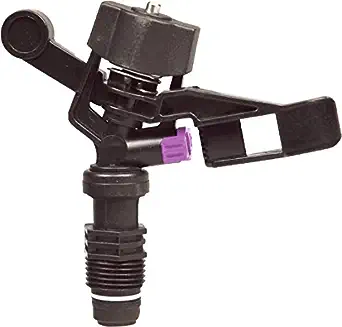
Low-pressure sprinklers are an excellent choice for properties with low water pressure. This type of sprinkler has a special nozzle that produces larger water droplets, enabling it to cover more ground than traditional sprinklers. Low-pressure nozzles also require less water pressure—about 15 psi or less—making them ideal for properties with low-pressure systems.
Pros:
- Low-pressure sprinklers are great for areas with limited water pressure.
- They also create large droplets of water that reduce evaporation and runoff, making them an efficient choice for watering small to medium-sized lawns.
- Additionally, they are easy to install and operate.
Cons:
- Unfortunately, low-pressure sprinklers have a limited coverage range—up to 800 square feet—and are unsuitable for large areas or lawns. Also, larger water droplets may cause soil compaction if used too often.
- Lastly, the nozzles require regular maintenance to ensure proper watering.
Overall, plenty of sprinkler systems on the market can fit your needs. Whether you’re looking for a system to cover a small garden or a large lawn, it’s essential to research each type and find one that best fits your watering needs. With proper installation and maintenance, you can ensure that your lawn stays healthy and green all season long.
Tips for Successful Sprinkler Installation:
When installing a new lawn sprinkler system, it is essential to consider the following key tips to ensure a successful installation:
- Measure the area to determine how many sprinkler heads are needed.
- Install the sprinkler heads in an even pattern and adjust them to ensure they all face the same direction.
- Place your water supply line in an accessible location that has proper drainage.
- Choose a high-quality outdoor timer to ensure your sprinkler turns off and on when it should.
- Use a rain gauge or soil moisture sensor to monitor the amount of water used to avoid over-watering accurately.
Factors to Consider When Selecting the Best Type of Sprinkler
Here are some critical factors to consider when choosing the right sprinkler for your lawn:
- Size of the lawn: Assess the appropriate coverage area and select the sprinkler that meets that need.
- The shape of the lawn: Look for sprinklers that can adequately cover your lawn’s condition, whether square, circular, or irregular.
- Water pressure: Be mindful of your water supply pressure; some sprinklers require specific pressures to function correctly.
- Water conservation: Opt for sprinklers with efficient water usage, such as low-flow models or those with built-in timers and rain sensors.
- Weather patterns: Consider your local climate, as arid regions might need a more efficient water distribution method.
- Available budget: Assess your budget and invest in durable, reliable, and well-reviewed sprinklers for long-lasting results.
Expert Recommendations on Sprinkler Types for Different Lawns
Let’s conclude with my expert advice on which sprinkler types work best for different lawn conditions:
- Small and flat lawns: A stationary or oscillating sprinkler will suffice, delivering gentle and even watering coverage.
- Medium to large lawns: Rotary or pulsating sprinklers offer excellent range and adaptability for various lawn shapes.
- Custom shapes and garden beds: In-ground sprinklers with adjustable nozzles provide precise water delivery, while sprinkler hoses offer flexibility, shaping according to your garden layout.
- Expansive or intricate lawns: Invest in a traveling sprinkler, which can autonomously water different areas without manual labor.
Conclusion
No matter the size and shape of your lawn, there is a sprinkler type that can meet your needs. By carefully examining these factors and understanding which sprinklers work best for different conditions, you can select one that efficiently waters your lawn while considering water conservation.
Whether looking for a short-term or long-term solution, sprinklers are an easy and efficient way to ensure your lawn stays lush and healthy. With the correct type of sprinkler, you can keep your land looking its best for years.
Sprinklers are also great for larger outdoor areas such as sports fields, gardens, and driveways. With the suitable sprinkler model, you can ensure thorough coverage of these areas without wasting water—a win-win for any homeowner.
For more tips on selecting the best sprinkler for your lawn, check out our comprehensive guide. It’s packed with advice from sprinkler experts and includes step-by-step instructions to help you find the perfect solution for your outdoor space.

Douglas Mackalie is a Founder of Mackalies Garden. He is one of the most exciting people you’ll ever meet. He has 25 years of experience in horticulture and gardening, most of which he’s spent outdoors getting his hands dirty.
